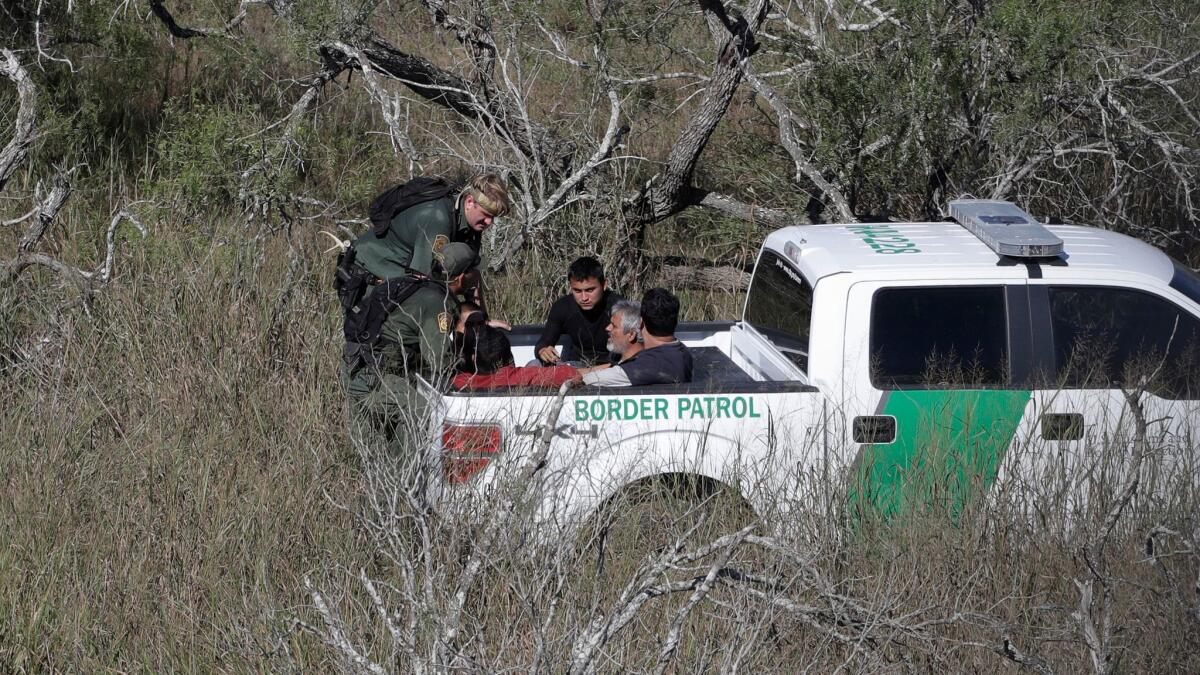A board set up to investigate Border Patrol shootings and deaths has cleared agents every time

Reporting from Washington â In rural Arizona, a border agent shot at and missed a migrant who had cocked his arm to throw a rock. At a California border station, a man died after being hit with a Taser three times.
Neither time did agents breach Customs and Border Protection policy, according to a board set up this year to provide accountability and oversight for how agents deploy force in their often dangerous border confrontations. So far, the board has considered eight cases, and it has cleared agents each time.
The latest four case reviews, released last week, illustrate the challenges for an agency struggling to overhaul its practices after a string of alleged abuses including high-profile cross-border shootings, sometimes in response to thrown rocks. The boardâs creation was the latest step in a four-year effort to modernize policing standards at Customs and Border Protection and in particular in the Border Patrol, with its rough-edged, military-style culture.
Civil rights advocates who work on border policy say they are disappointed in the reviews. One said he was disturbed that the board cleared the Arizona shooting; others have said the Border Patrol essentially sanctioned agents firing their weapons instead of retreating in response to rocks.
âThat certainly raises a whole lot of alarms in our minds,â said Christian Ramirez, director of the Southern Border Communities Coalition. âThat seems to counter what law enforcement experts have already established â using a firearm against a rock-thrower should not be within policy.â
The summaries released by the board donât reveal why its members concluded the agents stayed within the rules, nor do they criticize the agencyâs policies or offer ideas on how agents might have better handled the confrontations. The board has recommended changes in policy and training, 18 in total, but Customs and Border Protection has not released them.
âYou donât see what the recommendations are, and they donât really tie the conclusions to the policies in a clear manner,â said Chris Rickerd, a border policy expert at the American Civil Liberties Union. âThese short clearances really speak to the need for a different type of transparency in these cases.â
Concerns over curbing potential abuses have become sharper since the victory of President-elect Donald Trump, who promised tougher border enforcement as a central theme of his campaign.
Ramirez says he hopes the more detailed findings will be released now, to guide further reforms. He worries that groups like his, which tracks violent border encounters, will be shut out during a Trump administration.
âIt will be a shame if we go back to the days when [Customs and Border Protection] lost transparency,â he said. âWe keep pushing.â
Four years ago, amid growing outrage and facing lawsuits, Customs and Border Protection began to reexamine its practices, starting with a review of 67 cases by a professional policing group that found serious failings in how the agency limited deadly force. The agency in 2014 adopted a new policy manual that, among other changes, instructs agents to try to avoid shooting at rock throwers, and to retreat first.
Ramirez says heâd never heard of the latest such shooting until the report was released.
On patrol in April 2015, two agents split up to look for a group of migrants. One agent saw five men carrying burlap packs, the kind commonly used by drug mules. He hid behind a small tree and, when he figured heâd been spotted, ordered them to halt.
Four scattered, but one picked up a rock and raised his arm. The agent fired one shot from his rifle and missed. The man dropped the rock and ran away.
A family outing, then a deadly Border Patrol shooting Âť
In that case, and in two others reported in July, the board, made up of officials from Customs and Border Protection and civil rights officials from the departments of Justice and Homeland Security, concluded that firing at rock throwers was justified because the agents faced a legitimate threat.
In the San Ysidro border station case, on Christmas Eve 2014, 40-year-old Francisco Cesena of El Cajon was detained after a records check showed he was wanted on a warrant. Agents say a search turned up a package with 7 grams of heroin taped to his groin.
Officials say Cesena jumped a desk and began punching an officer. In the ensuing struggle, an officer pressed a Taser against his body, firing three times in drive stun mode, which delivers a painful electric shock but not paralysis.
The Border Patrol has a history of excessive force involving the Taser, and the 2014 manual says agents should not use the device more than three times. Matthew Klein, assistant Customs and Border Protection commissioner in charge of internal investigations, says that for each time the Taser trigger is pulled during a confrontation, the review panel examines âwhether at that very moment the agent used appropriate forceâ to counter resistance.

Early on March 15, 2012, Alex Martin was spotted by a Border Patrol agent on a rural stretch of Interstate 8 near Pine Valley, Calif. The agent said Martin was driving on the wrong side of the road. This video shows the pursuitâs fatal conclusi
Cesenaâs sister, Brenda Cesena-Cruz of El Cajon, says she isnât satisfied with the findings in the review of her brotherâs death, noting that an autopsy also found that he suffered broken ribs and bruises.
âI donât believe that anyone deserves to be treated the way he was treated,â she said. âWeâre going to continue to seek justice.â
In another Taser case, Jessica Cooke, a 21-year-old criminal justice major upset with agents detaining her at a border checkpoint in New York, began âflailing her arms,â according to agents, and hit one of them. Another agent shot her in the back with a Taser in an encounter captured in part by Cooke on her cellphone.
In a fourth case in the latest report, an agent in Washington state near the Canadian border shot a man in the head after the man sprayed him with bear repellent. The man died and turned out to be a murder suspect.
Klein says heâs confident the board is working as itâs supposed to, though he wouldnât comment on its decisions. The board reviews each shooting and every case that results in a death or serious injury.
âThe board looks very carefully at each incident and examines the agentâs actions based on policy and what is allowed by law, based on the threat,â he said.
As for the recommendations, Klein says Customs and Border Protection intends to release summaries but not the specifics of each case to protect possibly sensitive information. The case studies may be used to further overhaul training, he said, or to rewrite tactics and policies.
Klein said the changes at Customs and Border Protection have already reduced agentsâ use of force, including firearms. Uses of force declined 26% in the fiscal year that ended in October 2015; for the first 11 months of fiscal year 2016, the latest data available, uses of force are slightly higher, but shootings decreased.
The president of the union representing Border Patrol agents, which endorsed Trump, says the use-of-force rules are still open for negotiations between the union and the agency. He says he is mostly satisfied with the current policies, but not always happy with how they are applied by Customs and Border Protection leaders.
âThey got a lot of policy correct there, but there are tweaks that have to happen,â said Brandon Judd, who met with Trump on Monday.
âIf you feel that serious bodily injury or death can result from what an individual is doing, weâre authorized to use deadly force,â he said. âThat hasnât changed.â
Times staff writer Brian Bennett contributed to this report.
Twitter: @jtanfani
ALSO:
How Trump could use the presidency to help his own business interests
Rolling out Obamacare was chaotic, but a repeal could be much worse
More to Read
Sign up for Essential California
The most important California stories and recommendations in your inbox every morning.
You may occasionally receive promotional content from the Los Angeles Times.











